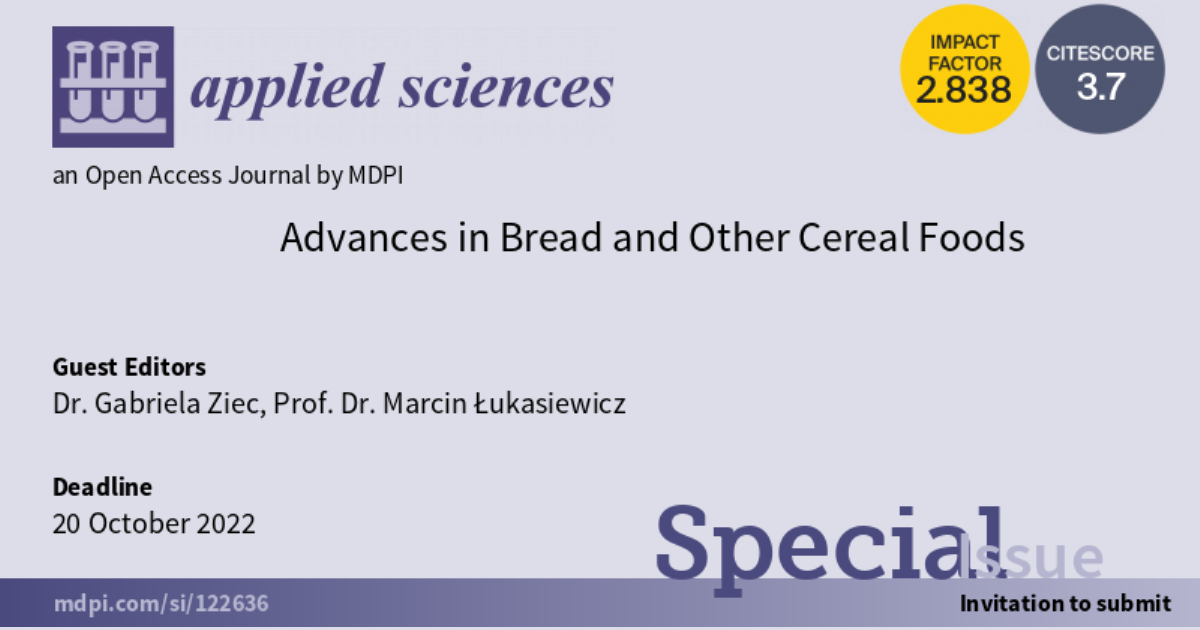Advances in Bread and Other Cereal Foods
A special issue of Applied Sciences (ISSN 2076-3417). This special issue belongs to the section "Food Science and Technology".
Deadline for manuscript submissions: closed (20 October 2022) | Viewed by 1913

Special Issue Editors
Interests: cereals science and processing; carbohydrate technology; increasing the nutritional value of gluten-free bread; chromatography in food analysis; enrichment of conventional bread with non-bread flours; developing biscuits recipes with functional properties; texture of ceral food
Special Issues, Collections and Topics in MDPI journals
Interests: chemical calculations; carbohydrate technology; natural sweeteners; modern aspects of carbohydrate chemistry and technology; chromatography in food analysis; cyclodextrin technology; starch industry
Special Issues, Collections and Topics in MDPI journals
Special Issue Information
Dear Colleagues,
Bread is made from just a few ingredients, and its baking is a seemingly simple but very complicated process. Bread and other grain products are extremely important in the human diet. Moreover, to increase its nutritional value, bread is supplemented with minerals or vitamins or the addition of natural ingredients, such as non-bread cereals, cereal products, legume seeds, milk, high-protein products and many other foods that are characterized by a high nutritional value. Additionally, the application of sourdough for production of high-quality bread is very important, and gluten-free bread remains a big challenge for producers.
In the above context, research on grain products is extremely important. This Special Issue will be dedicated to new perspectives on the chemical and functional properties of bread and other cereal foods. Subjects that will be discussed in this Special Issue will focus not only on modern methods and technologies, but also functional and nutritional value. Topics include: innovations of cereal products and processing, fermentation, nutritional value, quality and more.
Dr. Gabriela Ziec
Prof. Dr. Marcin Łukasiewicz
Guest Editors
Manuscript Submission Information
Manuscripts should be submitted online at www.mdpi.com by registering and logging in to this website. Once you are registered, click here to go to the submission form. Manuscripts can be submitted until the deadline. All submissions that pass pre-check are peer-reviewed. Accepted papers will be published continuously in the journal (as soon as accepted) and will be listed together on the special issue website. Research articles, review articles as well as short communications are invited. For planned papers, a title and short abstract (about 100 words) can be sent to the Editorial Office for announcement on this website.
Submitted manuscripts should not have been published previously, nor be under consideration for publication elsewhere (except conference proceedings papers). All manuscripts are thoroughly refereed through a single-blind peer-review process. A guide for authors and other relevant information for submission of manuscripts is available on the Instructions for Authors page. Applied Sciences is an international peer-reviewed open access semimonthly journal published by MDPI.
Please visit the Instructions for Authors page before submitting a manuscript. The Article Processing Charge (APC) for publication in this open access journal is 2400 CHF (Swiss Francs). Submitted papers should be well formatted and use good English. Authors may use MDPI's English editing service prior to publication or during author revisions.
Keywords
- wheat and gluten free bread
- quality and nutritional value of cereal foods
- cereal biscuits
- sourdough
- innovations





